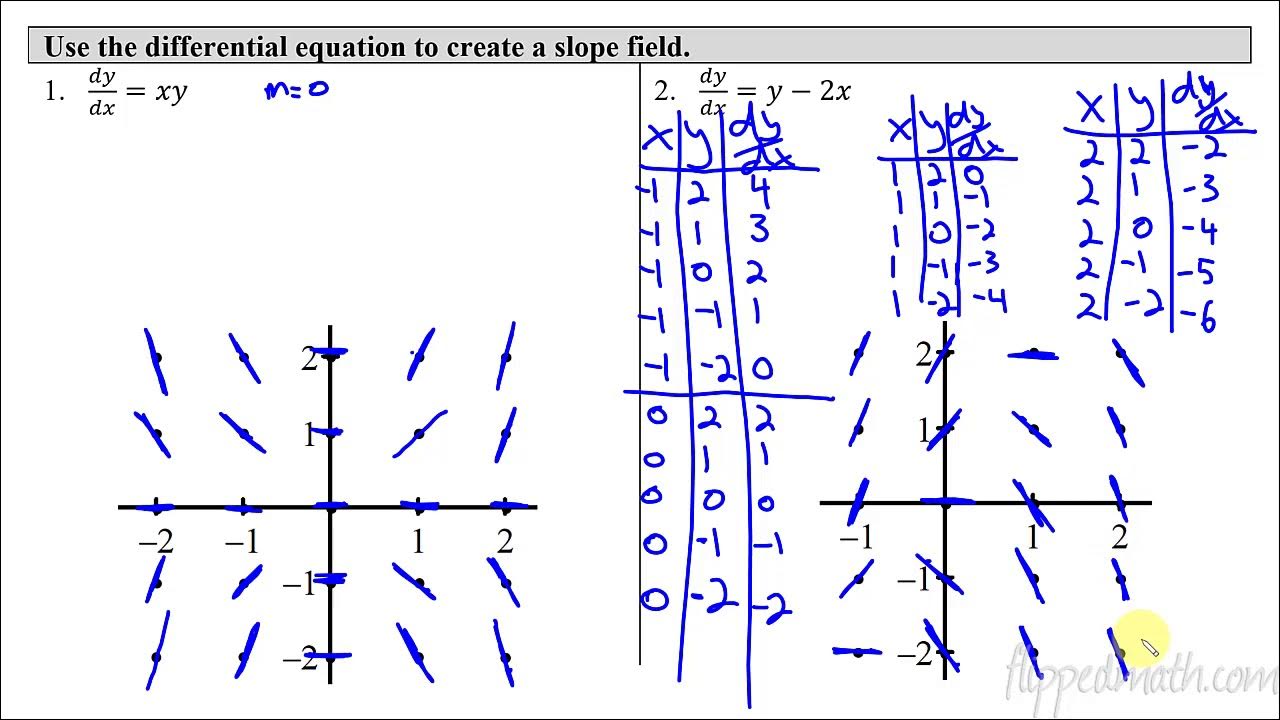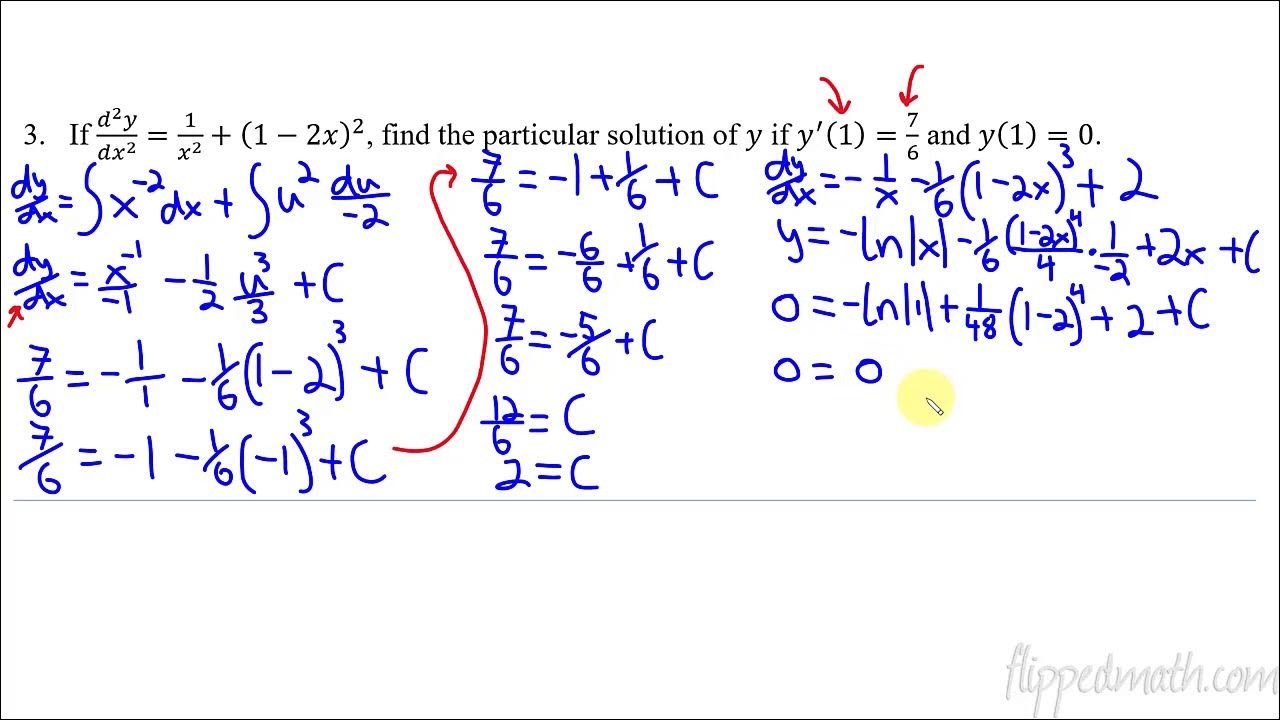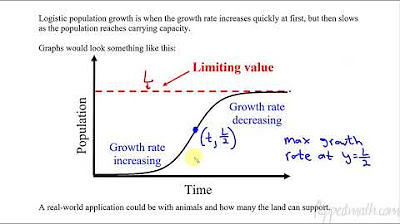Calculus AB/BC – 7.4 Reasoning Using Slope Fields
TLDRIn this engaging calculus lesson, Mr. Bean guides students through the intricacies of slope fields, illustrating how to visualize and understand the behavior of functions and curves. Starting with a sketch of a function that passes through a specific point, the lesson delves into identifying particular solutions that align with the slope field. Mr. Bean emphasizes the importance of accurately plotting points and following the 'current' of the slope field to predict the curve's direction. The video also tackles the challenge of matching a given slope field to its corresponding differential equation, using a combination of elimination and understanding of function families. Furthermore, the lesson explores identifying points where the derivative equals a specific value, demonstrated through algebraic manipulation and graphical analysis. Mr. Bean concludes with a critical examination of mismatches between a differential equation and its purported graph, highlighting the need for consistency in slopes across different y-values. This comprehensive overview not only reinforces the concept of slope fields but also equips students with the analytical skills to tackle complex calculus problems.
Takeaways
- 📈 The lesson focuses on using slope fields to understand the behavior of a function or curve, taking the concept to a deeper level.
- 🔍 The process involves sketching a curve based on a slope field, which gives a sense of the curve's general shape without needing to be exact.
- 🍃 The analogy of a leaf in a river current is used to describe how a point on the curve would move according to the slope field.
- 📌 Specific points, such as Point A (0, 2) and Point B (-1, -2), are used to demonstrate particular solutions that pass through those coordinates.
- 🖥️ Online tools like flipmath.com can be utilized to plot points and verify the accuracy of hand-sketched slope fields.
- 🔑 The importance of understanding the difference between finding a solution to a differential equation and identifying the differential equation itself is emphasized.
- ✋ It's crucial to recognize the general shape of a graph and have knowledge of function families when analyzing slope fields.
- 🚫 Elimination is a useful technique when choosing the correct function that matches a given slope field, as demonstrated by disproving options C and A.
- 📐 The process of finding when the derivative equals a specific value, such as -1, involves both graphical analysis and algebraic manipulation.
- 🤔 The lesson highlights the need for careful consideration when comparing a differential equation to a graph, as small inconsistencies can indicate a mismatch.
- ❌ A common mistake is expecting a constant slope across a line for a given differential equation, which is checked by analyzing the slope field.
- 📚 The lesson concludes with a reminder to practice both interpreting slope fields and solving differential equations, as both are important for a comprehensive understanding.
Q & A
What is the main topic of the lesson?
-The main topic of the lesson is the use of slope fields in calculus to understand the behavior of functions or curves.
What does the term 'slope field' represent?
-A slope field is a graphical representation that shows the direction and rate of change (slope) of a function at various points in its domain.
How is a particular solution to a slope field defined?
-A particular solution to a slope field is a specific path or curve that fits the slope field and passes through a given point.
What is the process of sketching a slope field?
-Sketching a slope field involves drawing a rough approximation of the curve that follows the 'current' of the slope field, indicating the general direction and steepness of the slope at different points.
Why is it important to understand the family of functions when working with slope fields?
-Understanding the family of functions helps in predicting the general shape of the solution curve and identifying characteristics such as asymptotes, maxima, minima, and other behavior of the function.
What is the purpose of using an online tool like the one mentioned on flipmath.com?
-The online tool allows students to input the equation of a slope field, plot points, and visually check if their sketch matches the actual solution, aiding in learning and practice.
How does one determine if a given differential equation matches a slope field?
-One must solve the differential equation to find its general solution and then check if the particular solution that passes through a given point aligns with the slope field.
What is the significance of identifying vertical asymptotes in a function?
-Vertical asymptotes indicate values of x where the function approaches infinity or negative infinity, which are important for understanding the behavior of the function and its limitations.
Why might a student confuse a slope field problem with a differential equation problem?
-Students might confuse the two because both involve the concept of derivatives and rates of change. However, a slope field problem asks for the solution that fits the given field, while a differential equation problem asks for the equation that generates the field.
What does the process of elimination involve when trying to match a solution to a differential equation?
-The process of elimination involves systematically ruling out options that do not satisfy the conditions of the problem, such as not passing through a specific point or not having the correct asymptotic behavior.
How can a slope field help in solving problems related to differential equations?
-A slope field provides a visual representation of the solutions to a differential equation, making it easier to identify the correct solution curve, locate asymptotes, and understand the overall behavior of the function.
What is the key takeaway from the lesson regarding the use of slope fields?
-The key takeaway is that slope fields are a powerful tool for visualizing and reasoning about the solutions to differential equations, helping to identify particular solutions, understand the behavior of functions, and develop a deeper intuition for calculus problems.
Outlines
📈 Introduction to Slope Fields and Calculus
The video begins with Mr. Bean welcoming viewers to a calculus lesson focused on slope fields. He introduces the concept of using slope fields to understand the behavior of functions and curves. The lesson starts by revisiting a graph from a previous lesson, plotting a point A at (0, 2) and sketching the curve's behavior based on the slope field. The sketch illustrates the curve's direction influenced by the slope field, likening it to a leaf moving with the current of a river. Mr. Bean also discusses plotting point B at (-1, -2) and emphasizes the importance of sketching from the slope field. He directs viewers to an online tool on flipmath.com for further practice and validation of their sketches. The lesson then transitions to finding the equation that corresponds to a given slope field, differentiating between finding the differential equation and the solution to that equation.
🧮 Identifying the Correct Function from a Slope Field
The second paragraph delves into the process of identifying the correct function from a slope field. Mr. Bean discusses the need to understand the family of functions and the general behavior of functions. He eliminates options C and A from a set of graphs by analyzing the behavior at specific points and the presence of vertical asymptotes. He then focuses on option D, which involves the tangent function, known for its multiple vertical asymptotes. After eliminating tangent due to its不符合 the graph's behavior, he confirms that option D is the correct answer by graphing it on a calculator and comparing it with the sketched slope field. Mr. Bean emphasizes the importance of distinguishing between being asked for a solution or a differential equation and stresses the need for knowledge of function families.
🔍 Describing Points with a Specific Derivative Value
In the third paragraph, Mr. Bean addresses a problem that might appear on the free-response section of an AP exam, which involves describing points where the derivative equals -1 within a given slope field. He demonstrates how to identify these points on the slope field and then algebraically solves for when the derivative equals -1, resulting in the equation y = -x - 1. He explains that all points on this line represent where the derivative is -1. The paragraph concludes with a discussion on why a given differential equation does not match a provided graph, highlighting the inconsistency in the slopes across different y-values and using this discrepancy to explain the mismatch. Mr. Bean wraps up by summarizing the lesson's focus on using slope fields to reason about the behavior of curves and to identify particular solutions.
Mindmap
Keywords
💡Slope Field
💡Particular Solution
💡Asymptote
💡Differential Equation
💡Family of Functions
💡Free Response
💡Process of Elimination
💡Derivative
💡Graph Sketching
💡Vertical Asymptote
💡Tangent Function
Highlights
Introduction to using slope fields to understand the behavior of a function or curve.
Demonstration of plotting a point (0, 2) labeled as point A on a 1 - xy graph.
Sketching the curve according to the slope field to get a feel for the curve's shape.
Labeling point A and sketching another particular solution through point B (-1, -2).
Using an online tool to check the accuracy of the sketched slope field.
Differentiating between finding the differential equation and finding the solution to that equation.
Elimination process to identify which graph matches the particular solution that goes through (0, 0).
Understanding the importance of recognizing the general shape of functions and their asymptotes.
Solving for when the derivative equals negative one using the slope field and algebraic manipulation.
Identifying all points that fall on the line y = -x - 1 where the derivative equals negative one.
Highlighting the necessity of algebraic understanding in addition to graphical representation.
Discussing why a given differential equation dy/dt does not match the provided graph.
Providing a method to determine if a slope field matches a differential equation by checking for consistent slopes.
Emphasizing the importance of recognizing when a problem is asking for a solution or a differential equation.
Using process of elimination and understanding of function families to solve problems related to slope fields.
Encouraging practice with slope fields to master the skill for potential free-response questions on exams like AP Calculus.
Summary of the lesson's focus on using slope fields to reason about curves and find particular solutions.
Transcripts
Browse More Related Video

Calculus AB/BC – 7.3 Sketching Slope Fields

Calculus 1: Slope Fields Examples

Calculus AB/BC – 5.8 Sketching Graphs of Functions and Their Derivatives

AP Calculus AB: Lesson 7.2 Slope Fields

Calculus AB/BC – 7.2 Verifying Solutions for Differential Equations

Calculus BC – 7.9 Logistic Models with Differential Equations
5.0 / 5 (0 votes)
Thanks for rating: